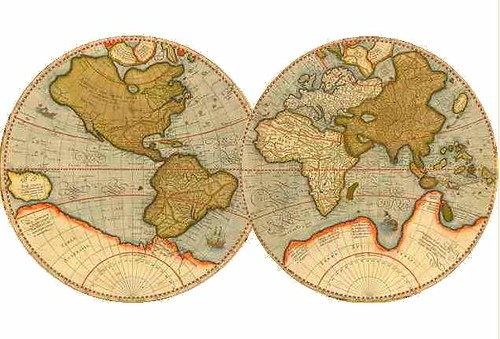
Discoverer's Day
Usually when we think of Discoverers, images of Christopher Columbus, Lewis and Clark, Marco Polo and other explorers come to mind. But these men and many others who traversed the land and seas in search of new lands not only discovered another continent, the American West, or the Far East but also the foods that grew there. The discovery of foods was critical for the creation and survival of civilization. Explore Splendid Palate and discover your new favorite food.
"The discovery of a new dish does more for human happiness than the discovery of a new star."
Jean-Anthelme Brillat-Savarin, The Physiology of Taste (1825)
Pre-historic man not only discovered many of the foods that we eat today but also ways to cook these foods. The quest for survival propelled man to discover ways to capture wild game, preserve fire, forage for food, cultivate food and raise livestock. Early man learned quickly that it was easier to hunt and gather in groups. Thus the first communities were founded and civilization as we know it was beginning to form.
Early man was nomadic, moving from place to place in pursuit of food. 800,000 years ago man was able to contain fire, thus they would be able to cook small animals they were able to capture; making them digestible, palatable, and/or sanitary. The bow and arrow was invented 10,000 years ago, facilitating the hunting of larger game, which could feed a larger community and could last longer if preserved right. Since, man no longer needed to move as often, agriculture began to develop. Agrarian society altered the path humans were to take forever. Man no longer had to move as the seasons dictated to find animals and wild berries and grains. Thus, wheat and other grains could be cultivated and stored over the winter. In essence, wild plants had to be domesticated so that they could be planted in a contained area and harvested annually. Grains were among the first plants to be cultivated. Lentils, dates, walnuts, and beans were cultivated later, between (8,000-6,000 B.C). Man had to discover a way to mill the wheat and barley so that it could be cooked into a gruel or bread otherwise it would be virtually indigestible. Various forms of cooking were developed during this time as well. Cattle, goats and sheep were domesticated since there were enough crops to feed them. These animals were used for meat, milk; bones used as utensils, stomachs as cooking vessels, skin and fur as clothing. From these small agrarian communities, villages and then cities arose. The pig was not domesticated until around 7,000 B.C. because the pig couldn’t survive even a minimally nomadic life and the pig was fed on human leftovers and not by grazing. Prior to the agrarian community, men were mainly responsible for hunting while women concentrated their efforts on gathering and cooking. In these villages and cities, there were enough people to create a division of labor that was new to civilization. Now, only a few men were required to cultivate the land and hunt but everyone still needed the fruits of their labor so commerce was developed. As rulers amassed wealth, they were able to create armies of men that would capture more land for their domain. As a result, new foods and technology were discovered thus trading between regions began.
By the Roman Period, trade became fully developed and many foods were imported around the world. Also more foods were cultivated and more animals were domesticated and thus many more foods were being discovered around the world. Spices were the most highly prized commodities, propelling the trade industry into a highly lucrative industry. After the fall of the Roman Empire, little trade was conducted between Europe and Asia during the Middle Ages. The Moors revitalized some trade along the Mediterranean. From the 15th Century to the 20th Century there was a dramatic increase in the trading of spice, coffee, chocolate and tea. European countries were in a race to develop faster ships to reach their destinations and new sea routes that would be shorter. Wars broke out over control of regions that grew the products and colonies were formed in those areas as a result.
The Industrial Revolution brought on a whole new food industry; many new packaged products were invented. Glass jars were massed produced enabling many new foods to be packaged. Refrigeration made it possible to preserve perishable produce for long enough for people to discover new foods from around the world that they never had before. Large machinery and gas stoves rather than wood burning hearths made it possible for the mass-production of food. People were discovering new foods and new combinations of ingredients at a rate inconceivable prior to the Industrial Revolution. Today, there are so many foods that one can’t possibly keep up with all the new foods. Discoverer’s day is the perfect day to try a few new foods. Forage ahead and discover what the world has to offer. You may not be discovering a creek in the Amazon but you will be expanding your horizons in your very own kitchen.
Food Timeline:
Prehistoric: Salt is discovered
Prehistoric: Fish are caught
Prehistoric: Rice is discovered
800,000 years ago: Man controls fire
10,000 years ago: Bow and arrow invented in Europe
10,000 years ago: Sheep domesticated in Near East
10,000 years ago: Sheep domesticated in Near East
10,000 years ago: Goat domesticated in Persia
6,000 years ago: Sail propelled boats used in Egypt
5,500 years ago: Wheel invented in Sumer
5,000 years ago: Plow is invented in the Near East
5,500 years ago: Potatoes cultivated in South America
4,000 years ago: Chicken domesticated in the Indus valley
2,700 years ago: Rome is founded
17,000 B.C.: Emmer Grain is gathered
10,000 B.C.: Agriculture begins
10,000 B.C.: Bread is created
8,000 B.C.: Lentils are cultivated
7,000 B.C.: Pigs are domesticated
7,000 B.C.: Walnuts and beans are cultivated
6,000 B.C.: Dates and Maize are cultivated
6,000 B.C.: Cheese is discovered
5,500 B.C.: Honey and sugar is discovered
5,500 B.C.: Chickpeas are cultivated
5,000 B.C.: Olive Oil is discovered
5,000 B.C.: Squash is cultivated
4,000 B.C.: Grapes are cultivated
4,000 B.C.: Oranges are cultivated
3,200 B.C.: Chickens are domesticated
3,000 B.C.: Peas, Fava Beans, Onions, Carrots are cultivated
3,000 B.C.: Many spices and tea is discovered
1,500 B.C.: Chocolate is discovered
850 B.C.: Celery is cultivated
500 B.C.: Artichokes are cultivated
500 B.C.: Sausages and pasta are created
300 B.C.: Bananas are cultivated
100 A.D.: The Romans invent cheesecake, ice cream and flan
800 A.D.: Codfish is discovered
1482: Columbus discovers America bringing Potatoes, Corn,
Tomatoes, Peppers, and peanuts to Europe.
1495: Marmalade is invented
1550: Pancakes are invented
1700: Shortbread is invented
1756: Mayonnaise is invented in England
1762: The sandwich is invented in England
1767: Man-made soda water is invented in England
1767: Grapes are introduced to California
1796: Pumpkin pie is invented in New England
1856: Condensed milk is invented
1863: Breakfast cereal is invented in America
1885: Evaporated milk is invented
1897: Jell-O is invented in America
1903: Tuna is canned
1911: Crisco is invented
1920’s: Frozen foods are created
1950’s: Many candies and Fast Foods are invented

2 comments:
That was really interesting. I love learning new bits of information.
Thanks! So glad you liked it.
Post a Comment